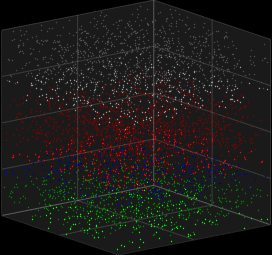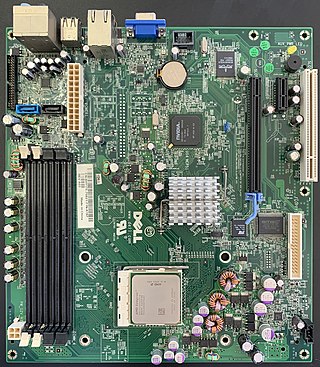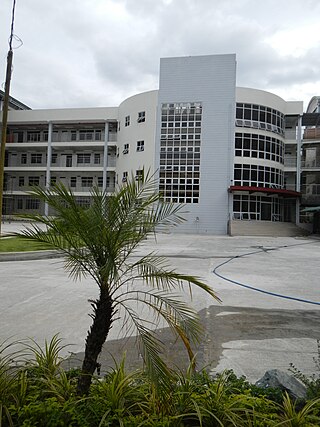Related Research Articles

Computing is any goal-oriented activity requiring, benefiting from, or creating computing machinery. It includes the study and experimentation of algorithmic processes, and development of both hardware and software. Computing has scientific, engineering, mathematical, technological and social aspects. Major computing disciplines include computer engineering, computer science, cybersecurity, data science, information systems, information technology and software engineering.

A wireless network is a computer network that uses wireless data connections between network nodes.

Computer engineering is a branch of electrical engineering and computer science that integrates several fields of computer science and electronic engineering required to develop computer hardware and software. Computer engineers not only require training in electronic engineering, software design, and hardware-software integration, but also in software engineering. It uses the techniques and principles of electrical engineering and computer science, but also covers areas such as artificial intelligence (AI), robotics, computer networks, computer architecture and operating systems. Computer engineers are involved in many hardware and software aspects of computing, from the design of individual microcontrollers, microprocessors, personal computers, and supercomputers, to circuit design. This field of engineering not only focuses on how computer systems themselves work, yet it also demands them to integrate into the larger picture. Robots are one of the applications of computer engineering.

Wireless communication is the transfer of information (telecommunication) between two or more points without the use of an electrical conductor, optical fiber or other continuous guided medium for the transfer. The most common wireless technologies use radio waves. With radio waves, intended distances can be short, such as a few meters for Bluetooth or as far as millions of kilometers for deep-space radio communications. It encompasses various types of fixed, mobile, and portable applications, including two-way radios, cellular telephones, personal digital assistants (PDAs), and wireless networking. Other examples of applications of radio wireless technology include GPS units, garage door openers, wireless computer mouse, keyboards and headsets, headphones, radio receivers, satellite television, broadcast television and cordless telephones. Somewhat less common methods of achieving wireless communications involve other electromagnetic phenomena, such as light and magnetic or electric fields, or the use of sound.

A wireless mesh network (WMN) is a communications network made up of radio nodes organized in a mesh topology. It can also be a form of wireless ad hoc network.

The Electrical and Electronics Engineering Institute of the University of the Philippines College of Engineering offers three undergraduate programs of study leading to the Bachelor of Science in Electrical Engineering (BSEE), Bachelor of Science in Electronics and Communications Engineering (BSECE), and Bachelor of Science in Computer Engineering (BSCoE) degrees. The Institute also offers graduate programs of study leading to the Master of Science in Electrical Engineering (MSEE) and Master of Engineering in Electrical Engineering (MEEE) degrees, and the Doctor of Engineering (DE) and Doctor of Philosophy (PhD) degrees in Electrical and Electronics Engineering. Various areas of specialization are offered in the graduate programs: Electric Power Engineering, Computer and Communications Engineering, Microelectronics, and Instrumentation and Control.

Telematics is an interdisciplinary field encompassing telecommunications, vehicular technologies, electrical engineering, and computer science. Telematics can involve any of the following:
The School of Engineering and Applied Science (SEAS) at the George Washington University in Washington, D.C. is a technical school which specializes in engineering, technology, communications, and transportation. The school is located on the main campus of the George Washington University and offers both undergraduate and graduate programs.

Sierra Wireless is a Canadian multinational wireless communications equipment designer, manufacturer and services provider headquartered in Richmond, British Columbia, Canada. It also maintains offices and operations in the United States, Korea, Japan, Taiwan, India, France, Australia and New Zealand.
A wireless ad hoc network (WANET) or mobile ad hoc network (MANET) is a decentralized type of wireless network. The network is ad hoc because it does not rely on a pre-existing infrastructure, such as routers or wireless access points. Instead, each node participates in routing by forwarding data for other nodes. The determination of which nodes forward data is made dynamically on the basis of network connectivity and the routing algorithm in use.
Samuel Lou Ginn, is an American businessman.

Telecommunications Engineering is a subfield of electrical engineering which seeks to design and devise systems of communication at a distance. The work ranges from basic circuit design to strategic mass developments. A telecommunication engineer is responsible for designing and overseeing the installation of telecommunications equipment and facilities, such as complex electronic switching systems, and other plain old telephone service facilities, optical fiber cabling, IP networks, and microwave transmission systems. Telecommunications engineering also overlaps with broadcast engineering.

Ian F. Akyildiz is a German academic. He received his BS, MS, and PhD degrees in Electrical and Computer Engineering from the University of Erlangen-Nürnberg, Germany, in 1978, 1981 and 1984, respectively. Currently, he is the President and CTO of the Truva Inc. since March 1989. He retired from the School of Electrical and Computer Engineering (ECE) at Georgia Tech in 2021 after almost 35 years service as Ken Byers Chair Professor in Telecommunications and Chair of the Telecom group.

Vijay K. Bhargava is a researcher and Professor in the Department of Electrical and Computer Engineering at the University of British Columbia (UBC). He served the department as its Head for 5 years. Before moving to UBC, Bhargava was a Professor in the Department of Electrical and Computer Engineering at University of Victoria.
Jesse Eugene Russell is an American inventor. He was trained as an electrical engineer at Tennessee State University and Stanford University, and worked in the field of wireless communication for over 20 years. He holds patents and continues to invent and innovate in the emerging area of next generation broadband wireless networks, technologies and services, often referred to as 4G. Russell was inducted into the US National Academy of Engineering for his contributions to the field of wireless communication. He pioneered the field of digital cellular communication in the 1980s through the use of high power linear amplification and low bit rate voice encoding technologies and received a patent in 1992 for his work in the area of digital cellular base station design.

Mobile technology is the technology used for cellular communication. Mobile technology has evolved rapidly over the past few years. Since the start of this millennium, a standard mobile device has gone from being no more than a simple two-way pager to being a mobile phone, GPS navigation device, an embedded web browser and instant messaging client, and a handheld gaming console. Many experts believe that the future of computer technology rests in mobile computing with wireless networking. Mobile computing by way of tablet computers is becoming more popular. Tablets are available on the 3G and 4G networks. Mobile technology has different meanings in different aspects, mainly mobile technology in information technology and mobile technology in basketball technology, mainly based on the wireless technology of wireless devices equipment information technology integration.
Microwave engineering pertains to the study and design of microwave circuits, components, and systems. Fundamental principles are applied to analysis, design and measurement techniques in this field. The short wavelengths involved distinguish this discipline from electronic engineering. This is because there are different interactions with circuits, transmissions and propagation characteristics at microwave frequencies.
Theodore (Ted) Scott Rappaport is an American electrical engineer and the David Lee/Ernst Weber Professor of Electrical and Computer Engineering at New York University Tandon School of Engineering and founding director of NYU WIRELESS.
RF CMOS is a metal–oxide–semiconductor (MOS) integrated circuit (IC) technology that integrates radio-frequency (RF), analog and digital electronics on a mixed-signal CMOS RF circuit chip. It is widely used in modern wireless telecommunications, such as cellular networks, Bluetooth, Wi-Fi, GPS receivers, broadcasting, vehicular communication systems, and the radio transceivers in all modern mobile phones and wireless networking devices. RF CMOS technology was pioneered by Pakistani engineer Asad Ali Abidi at UCLA during the late 1980s to early 1990s, and helped bring about the wireless revolution with the introduction of digital signal processing in wireless communications. The development and design of RF CMOS devices was enabled by van der Ziel's FET RF noise model, which was published in the early 1960s and remained largely forgotten until the 1990s.
Prathima Agrawal is an Indian-American computer engineer known for her contributions to wireless networking, VLSI, and computer-aided design. She is a professor emerita and the former Samuel Ginn Distinguished Professor of Electrical and Computer Engineering at Auburn University.
References
- ↑ "Wireless Engineering". Career Profiles. Retrieved 2008-10-06.
- ↑ Batista, Elisa (2002-08-30). "What's Your Major? Cell Phones". Wired. Retrieved 2008-10-06.
- ↑ "Wireless Engineering Program Outcomes". Career Profiles. Retrieved 2008-10-06.
- ↑ http://www.research.mq.edu.au/excellence/wireless_communications, Archived 2009-09-13 at the Wayback Machine